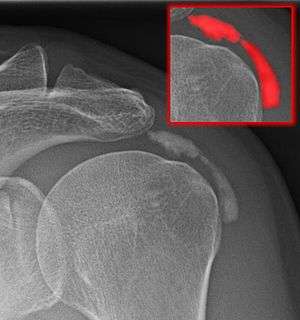Calcific bursitis
Calcific bursitis refers to calcium deposits within the bursae. This most occurs in the shoulder area. The most common bursa for calcific bursitis to occur is the subacromial bursa. A bursa is a small, fluid-filled sac that reduces friction, and facilitates movements between its adjacent tissues (i.e., between tendon and bone, two muscles or skin and bone). Inflammation of the bursae is called bursitis.
| Calcific bursitis | |
|---|---|
 | |
| Specialty | Rheumatology |
Signs and symptoms
- Pain during rest
- Tenderness on palpation
- Stiffness (reducing joint range of motion)
- Swelling
Causes
Calcific bursitis may be related to:
- Calcific tendinitis. Sometimes calcium deposits of the involved tendons penetrate into the bursae.
- Chronic bursitis. Lack of bursitis treatment or repetitive bursitis may lead to calcific bursitis.
Diagnosis
- X-ray
- MRI scan
Treatment
- Ice (in the acute stage)
- Rest (immobilization of the affected limb in the acute phase)
- Non steroidal anti-inflammatory drugs
- Injections of steroid
- Physical therapy
- Surgical treatment
gollark: So... if you eat conjured pasta... hmmmm...
gollark: Oh dear.
gollark: It's obvious: people just CONJURE vast quantities of gold as needed.
gollark: As planned.
gollark: Conjuring, shoe seller.
See also
References
- Darlene Hertling and Randolph M.Kessler. Management of Common Musculoskeletal Disorders. Third Edition. ISBN 0-397-55150-9
- Calcific bursitis at MedicineNet
This article is issued from Wikipedia. The text is licensed under Creative Commons - Attribution - Sharealike. Additional terms may apply for the media files.